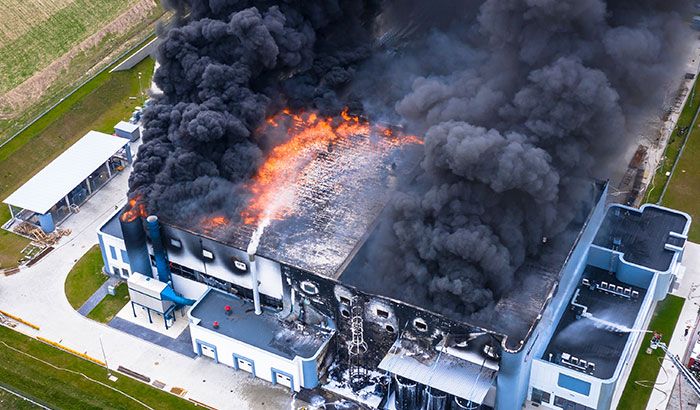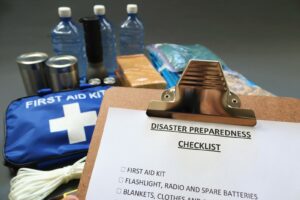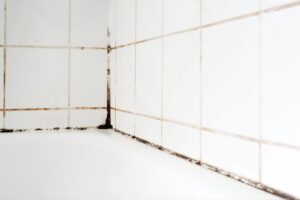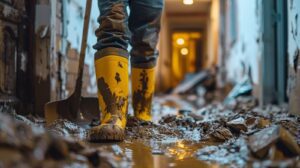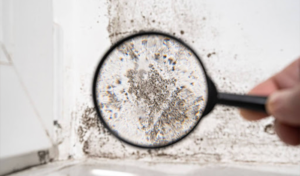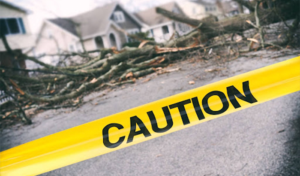Fires can be devastating, leaving behind smoke damage that can be challenging to identify and remediate.
Two of the most common types of fire damage are smoke stains and residue buildup. Smoke stains are visible discolorations on surfaces caused by smoke particles, while residue buildup is the accumulation of soot and other harmful substances from the fire.
This blog will explain the differences between smoke stains and residue buildup, how to identify them, and how to effectively remediate them to restore your property to its pre-fire condition. Keep reading to learn more.
Type 1: Soot Staining
Soot staining refers to the dark or black discoloration that happens when there’s incomplete combustion on a surface during a fire or burning process. It’s a type of smoke that occurs when smoke particles and residue settle on various surfaces in a property.
To identify soot staining, you can follow these steps:
- Visual Inspection: Begin by visually inspecting the surfaces of your property, paying attention to areas prone to collecting smoke residues. Look for dark, powdery, or greasy deposits on these surfaces. Soot staining is usually black or gray.
- Texture: Soot staining often leaves a distinct texture on surfaces. Run your finger across the suspected area and check if it feels gritty or smudges easily. Soot stains can have a grainy or powdery texture due to the fine particles in the residue.
- Presence of Soot Particles: Use a flashlight or bright light source to examine the affected areas closely. Soot particles may become more visible under strong illumination, allowing you to see the fine black particles settled on the surface.
- Odor: While this step focuses more on smoke odor — a separate type of smoke damage — the presence of a lingering smoky smell in an area can also indicate the presence of soot staining. Soot staining is likely present if you notice a distinct, charred odor in a specific location.
- Historical Information: Consider the context of the property. If there has been a recent fire or if you know that the property has experienced smoke damage, the presence of soot staining becomes more likely.
Type 2: Smoke Odor
Smoke odor is the lingering smell after smoke particles have settled on various surfaces or materials. Cigarette smoke, wildfires, or smoke from fires can all cause smoke odor.
To identify the smoke odor — whether it’s smoke from fire or another type — you can follow these steps:
- Visual Inspection: Start by looking for smoke damage. Look for changes in color, charred surfaces, and visible smoke residue on walls, ceilings, floors, and other surfaces. Smoke damage is often darker and appears as soot on surfaces.
- Smell: Smoke odor usually has a distinct acrid smell that can linger for a long time. If you notice an unusual or unpleasant odor in your property, try to pinpoint the location. Smoke odor can often be localized to specific areas, such as rooms, closets, and vents.
- Physical Examination: Conduct a physical examination of surfaces and materials for signs of smoke damage. Look for yellowing or discoloration of wallpaper and paint, often caused by smoke particles. Additionally, inspect your fabrics closely, as they often absorb smoke particles and carry the odor for an extended period.
- Air Quality: Check the air quality in your property. The air quality in a smoke-damaged area can have a high concentration of fine particulate matter, which can worsen respiratory problems. If you notice worsening asthma or allergy symptoms, it may indicate smoke damage.
- Historical Information: Consider the context of your property. If there has been a recent fire in the area or you live in a wildfire-prone area, smoke odor may be due to smoke damage.
Type 3: Fire Damage Residue
Fire damage residue refers to the residual substances or debris left behind after a fire. It consists of various materials and substances that can be harmful, corrosive, or pose health risks. The specific composition of fire damage residue can vary depending on the materials that burned, the temperature of the fire, and other factors.
Common types of fire damage residue include soot, ash, charred materials, and water damage residue. To identify fire damage residue, you can follow these steps:
- Visual Inspection: Conduct a thorough visual inspection of the affected areas. Look for signs of discoloration, charring, and soot on surfaces such as walls, ceilings, floors, and furniture. Fire damage residue may appear as black or gray patches, oily streaks, or powdery substances.
- Texture and Consistency: Pay attention to the texture and consistency of the residue. Soot, for example, is often powdery or oily and can smear when touched. On the other hand, ash is typically finer and lighter, resembling a grey or white powder.
- Odor: Fire damage residue can also produce a distinct, smoky odor. If you notice an unusual or strong smell of smoke or burning, it may indicate the presence of fire damage residue.
- Particle Testing: In some cases, you may need to perform particle testing to identify fire damage residue. This involves using specialized equipment, such as a high-efficiency particulate air (HEPA) filter or a microscope, to examine particles in the air or on surfaces. This method can help determine the presence of specific types of particles related to fire damage.
- Professional Assessment: If you are unsure about the extent or nature of fire damage residue, it is advisable to seek a professional assessment. Fire damage restoration specialists have the expertise and experience to identify and evaluate fire damage residue accurately. They can use specialized techniques and equipment to assess the residue and recommend appropriate cleanup and restoration measures.
Type 4: Smoke Stains
A smoke stain is a visible discoloration on surfaces caused by smoke particles. When materials burn, various types of smoke can cling to surfaces, causing them to appear brown, black, or yellow.
To identify smoke stains, you can follow these steps:
- Visual Inspection: Conduct a thorough visual inspection of the surfaces in the affected area. Look for visible discoloration, such as brown, black, or yellowish patches or streaks. Consider lighter-colored surfaces, as smoke stains are typically more noticeable.
- Variation in Color: Compare the affected surfaces with unaffected areas or surfaces in other parts of the space. Smoke-stained areas often exhibit a clear contrast in color or look different from their original state due to the discoloration caused by smoke particles.
- Difficult-to-Clean Surfaces: If you’ve attempted to clean surfaces but notice persistent discoloration or staining that doesn’t respond to regular cleaning methods, it may indicate the presence of smoke stains. Smoke particles can penetrate porous materials, making them difficult to clean with ordinary household cleaners.
- Lingering Odor: Smoke stains are often accompanied by a lingering smoky odor. If you notice a persistent smell of smoke, it may indicate the presence of smoke particles and can serve as an additional sign of smoke staining.
Have Total Flood & Fire Restoration Restore Your Home
Smoke staining can be frustrating, leaving surfaces unsightly and causing lingering odors. Residue buildup can pose health hazards and is often challenging to eliminate without professional help.
If you’re dealing with smoke from fire, smoke staining, or residue buildup, it’s essential to seek prompt, professional assistance to remediate the damage effectively. Total Flood & Fire Restoration provides comprehensive smoke restoration services to restore your property to its pre-fire condition, eliminating smoke staining, residue buildup, and any associated odors.
Our experts have the expertise and experience necessary to evaluate the damage, recommend the best strategies for remediation, and deliver effective results. Contact Total Flood & Fire Restoration today at 385.503.2846 to schedule a consultation and learn more about how we can help you restore your property.

